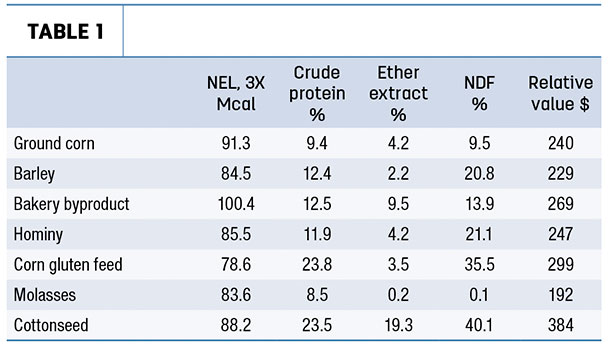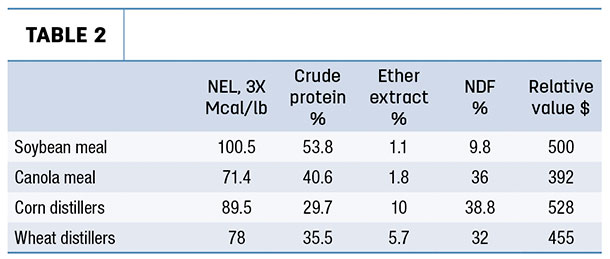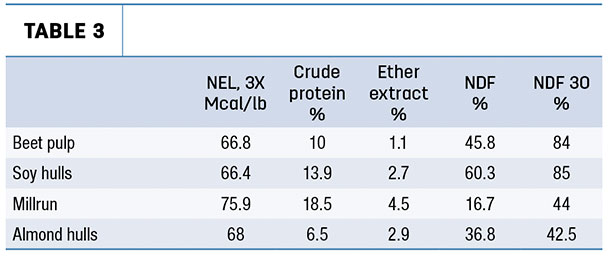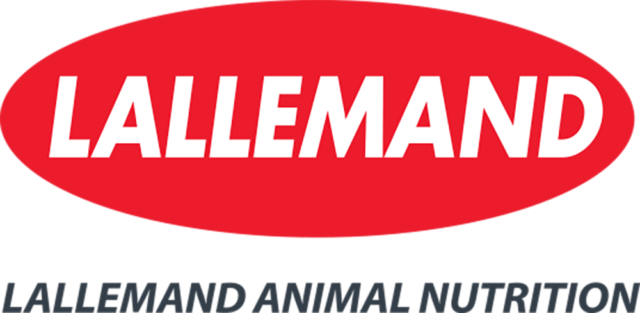Early in my career, I had a feed store manager tell me, “Only the rich can afford cheap feed.” While he was partially correct, feeding dairy cows does allow us the opportunity to feed a variety of byproducts, based upon their nutrient value. There are a variety of software options that can describe the relative value of byproducts compared to more traditional feedstuffs, such as alfalfa hay, corn silage, corn and soybean meal.
When feeding byproducts, there are a few factors we need to consider:
- The first is variability within the product. Most brokers will offer a guaranteed analysis of the product. While this provides for certain minimums (protein and fat content) and maximums (fiber content), they are strictly guidelines. Are the nutrients consistent load to load? Consistency of particle size in the byproduct can also be a factor impacting nutrient availability. As a nutritionist, we sample feeds to minimize variability, as we try to maintain a consistent delivery of nutrients to the cow.
- A second factor to consider is feed quality issues. The byproduct may test well, but does it have the risk of containing molds or mycotoxins?
- A third factor to consider is availability. A feed may be a great buy and be clean, but if it’s only available in limited or inconsistent quantities, then it’s probably not worth adding to the diet.
- A fourth consideration is the physical characteristics of the feed. Is it something you can handle on-farm, and will shrink be minimal? Some products like screenings, dust or blood meal are difficult to handle and may have high levels of shrink when handling with a payloader. This loss can make a good value become extremely high priced (consider applying a shrink factor to the quoted cost per ton).
Energy feeds
For energy feeds, the standard of comparison I’ll use is corn. Table 1 lists some nutrient values for corn and typical byproducts available, along with a dollar value relative to corn. I used $240-per-ton corn as a reference value. The number in the relative value column reflects the dollar amount you could pay for the byproduct compared to the corn price and have it still be of value in the ration. Nutrient values in the tables are from the Nutrient Requirements of Dairy Cattle(Dairy NRC), 2001. Because the byproducts bring value other than just energy, I’ve listed a few values to describe the feeds.

Barley
If corn is the industry standard for energy (and starch) in lactating dairy cow rations, barley runs a close second. The higher protein value in barley offsets the lower starch and higher fiber. Steam rolled barley can be fed pound for pound for corn successfully. However, if barley is fed ground, there needs to be a limit on the amount in the diet as it is more rapidly fermented in the rumen. Particle size, coupled with rate of fermentation, limits the amount that can be fed when it is ground.
Bakery byproduct
Typically bakery byproduct has good value in relationship to corn. Being higher in protein, sugar and fat, which pushes the calculated net energy of lactation (NEL) higher, it is generally a good partial replacement for corn. It can be highly variable between sources, as its values reflect the product mix it’s comprised of (i.e., Oreos are different from saltine crackers). A couple of potential issues worth testing for include fat and salt levels in the feedstuff. Given wheat flour is the predominant grain in this product, this creates limitations due to rapid fermentability. Product availability may be limited due to geographic locations where baked goods are created. Be aware that packaging (cardboard, plastic) is also known to sometimes make its way into these products.
Hominy
Hominy is another corn-based byproduct that is typically used as a partial replacement for corn in the diet. Chemically, it is higher in protein and fiber and has quite a bit of variability in fat content. Physical characteristics and fat content tend to limit the amount of hominy fed in dairy cow diets.
Corn gluten feed
Corn gluten feed (CGF) is a middle protein, middle energy byproduct of the high fructose corn syrup industry. As an energy source, it contains about 85% of the energy and about 20% of the starch and sugar content of corn. As a protein source, it is usually cost-effective; however, when feeding CGF in a high corn-based diet, protein quality (amino acid balance) can be an issue. Fat and protein variability can also be a challenge, so identifying a single source, coupled with period testing, is recommended.
Molasses
There are two primary sources for molasses, sugarcane and beet molasses. There is research suggesting replacing a couple of pounds of corn dry matter with dry matter from molasses will not hurt milk production and may improve components. This is somewhat diet dependent and may result from changing the rumen environment by replacing starch (on a high starch diet) with sugars. Molasses sugar content is measured in Brix, with pure molasses around 80 Brix. Caveats for evaluating molasses inclusion in the diet include dry matter of the product, total sugars as inverts (TSI) and the ash content of the product. Molasses is often cut with whey or CSB, a byproduct of the sugar industry, to create a product that is easier to deliver to livestock. Molasses may also bring value in that it can be used as a carrier to bring other products into the diet and the consistency is effective in “sticking” a diet together to reduce sorting.
Cottonseed
While cottonseed is considered a byproduct feedstuff, its unique combination of nutrients put it in a class by itself. It is high energy (primarily due to fat content). The high fiber and mid-protein make it fit in most dairy rations. Cottonseed inclusion benefits milk butterfat content and overall energy levels in the diet. Cottonseed should be limited to a maximum of 8 pounds in the diet due to gossypol concerns. The cottonseed market appears to operate independently of the corn/soy complex and should be evaluated periodically for the value it brings versus the cost of the product. Due to its size, cottonseed also provides some physical effective fiber to the ration.
Protein feeds
On the protein side of the world, the protein source other byproduct protein sources are compared against is soybean meal. In Table 2, I’ve listed nutrients and a relative value for soybean meal and other high protein byproducts common in the marketplace today.

Canola
Canola meal is a high-quality protein source, which like soybean meal, is created when the oil is removed from the seed. It can be a mechanical extraction, which tends to leave a higher residual fat level, or a combination of mechanical and solvent extraction. It can be a loose meal or pelleted (increased density for freight purposes). As a protein source, canola works well in diets with a higher legume forage base. The rates of protein degradation appear to match up well with those of a heavy alfalfa-based diet. Canola intakes should be limited as it does have a bitter taste and can negatively impact cow performance at high levels of dietary inclusion.
Corn distillers grains
Historically, dry distillers grains (DDGs) have been a fairly variable byproduct with tremendous variation in both fat and protein levels. Distillers grains are available as both wet and dried products. Wet distillers feeding is limited by the ability to economically haul the added moisture. Particle size and color (influenced by the amount of solids added back) have been highly variable. DDGs were traded by source plants to try to somewhat limit variation.
More recently, the industry has moved toward lower fat, higher protein products that are considerably more consistent, not only within plants but between plants also. DDGs are also recognized as a source of RUP (rumen undegradable protein), which may help their value. Caveats to feeding high levels of DDGs include sulfur levels, fat disrupting rumen fermentation and the possibility of concentrated mycotoxins.
Wheat distillers grains
Wheat dry distillers grains are similar to corn DDGs in that they are a byproduct to a fermentation industry. Wheat DDGs are slightly higher in protein and lower in fat than corn DDGs. Protein levels are similar to canola meal, so this can be used in substitution for canola in the short term. Caveats include the amino acid profile if feeding heavily in the diet.
High fiber byproducts
The last category of byproducts for lactating dairy cows to discuss is the high fiber byproducts. These products can partially replace concentrate and partially replace forage in the diet. They are somewhat regional as sometimes freight can be prohibitive to their pricing into a diet. All are moderate on energy, contain a relatively digestible fiber fraction and can be variable on protein. In Table 3, I added a column for NDF30 (neutral detergent fiber) and estimated the digestibility of the fiber fraction at a 30-hour time point.

Beet pulp
Beet pulp is a byproduct of the sugar beet industry. It contains a moderate amount of neutral detergent fiber (NDF) that is highly digestible (84% at 30 hours). Like DDGs, it can be fed wet, but is also dried and pelleted for transporting distances. Its fiber content, both chemical and physical, allows it to replace some forage in the diet, maintaining a healthy rumen environment, while allowing for enough energy to also replace some grain in the diet. Particle size is larger on shredded beet pulp than some of the other high fiber products, contributing to the “chew value” of the diet. Additionally, beet pulp is easier on mixing equipment than true forages, saving on time and wear and tear.
Soy hulls
Soy hulls are similar in chemical composition to beet pulp, although they lack the physical fiber that beet pulp contains. Particle size is consistently smaller than beet pulp, limiting additional rumination due to its inclusion in the diet. Again, this is probably more regionally fed and struggles to travel too great of a distance because of freight considerations.
Millrun
Millrun (or wheat midds) is a byproduct of the flour milling industry. It is a middle protein, giving it some extra value in the diet. Chemically, it contains digestible fiber and, like soy hulls, can replace some forage and some concentrate in the diet. It has a couple of limitations. First, as a fiber source, particle size is relatively small and is not going to stimulate cud-chewing. Secondly, it is a fairly light and powdery feedstuff, putting it at risk for large shrink losses if not handled properly.
Almond hulls
Almond hulls have probably the most variability of the high fiber byproducts. There are multiple grades that are marketed, based on the amount of shell in the product. When considering feeding almond hulls, you should get what you are buying well defined and follow up with chemical testing, otherwise performance can be disappointing. Almond hulls contain pectin and can be a good source of digestible fiber for dairy cows. Almond hulls have a large particle size and have been shown to have a positive impact on butterfat in milk.
One of the challenges of feeding almond hulls can be supply logistics. If you’re a California dairy producer, this is probably not an issue; however, beyond that state, sometimes delivery can be an issue. One should take particular care to make sure there is a backup plan if your delivery does not show up on time. A second concern regards storage of the product. While almond hulls won’t typically blow away with the wind, with the pectin content, they will grow a variety of molds if they get wet.
Bottom Line
With high feed prices, utilizing byproducts in the diet of dairy cattle provide us an opportunity to potentially reduce feed costs and improve animal performance or feed efficiency. While byproducts allow us flexibility in putting together diets, we still have to be cognizant of the basics of ruminant nutrition and put together diets that do not “violate” the rumen.







